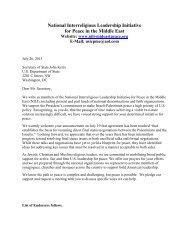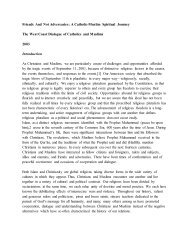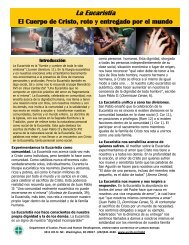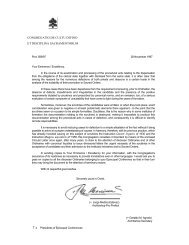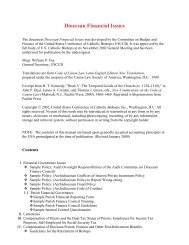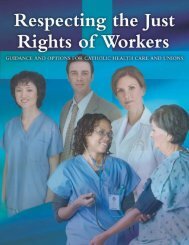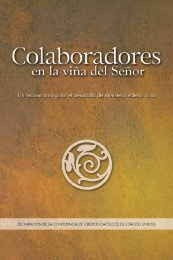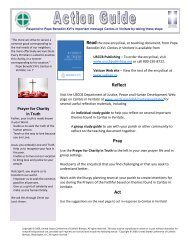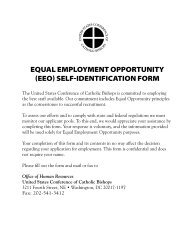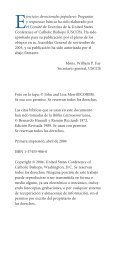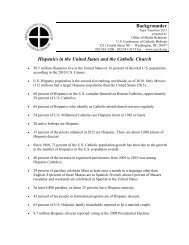Doctrinal Elements of a Curriculum Framework for the Development ...
Doctrinal Elements of a Curriculum Framework for the Development ...
Doctrinal Elements of a Curriculum Framework for the Development ...
- No tags were found...
Create successful ePaper yourself
Turn your PDF publications into a flip-book with our unique Google optimized e-Paper software.
. Common ties between <strong>the</strong> Catholic Churchand <strong>the</strong>se ecclesial communions.1) Common beliefs about Christ derivedfrom Scripture.2) Baptisms celebrated with <strong>the</strong> Trinitarian<strong>for</strong>mula and proper intention areconsidered valid by <strong>the</strong> Catholic Church.3) In many cases, common moralconvictions.4) Some common liturgical practices, e.g.,common cycle <strong>of</strong> Scripture readings.c. Differences.1) Differences in acceptance <strong>of</strong> <strong>the</strong> authority<strong>of</strong> <strong>the</strong> pope.2) Differences in doctrine, e.g., Calvinistbelief in predestination.3) Differences in sacramental economyand practice, particularly <strong>the</strong> lack <strong>of</strong><strong>the</strong> Sacrament <strong>of</strong> Holy Orders and,consequently, <strong>of</strong> a valid Eucharist.4) Differences on moral questions: e.g.,abortion, divorce, and remarriage.4. O<strong>the</strong>r Christian communities.a. Some are <strong>the</strong> result <strong>of</strong> fur<strong>the</strong>r divisionsamong ecclesial communions which separatedfrom <strong>the</strong> Catholic Church, e.g., Methodistsseparated from <strong>the</strong> Anglican Church.b. Shared belief in Christ and <strong>the</strong> Triune God buta strong emphasis on sola Scriptura (Scripturealone) as <strong>the</strong> standard <strong>for</strong> determining belief.c. Differences in doctrine, sacramentalunderstanding and practice, morality.d. Many <strong>of</strong> <strong>the</strong>se bodies (e.g., Baptists,Congregationalists) view <strong>the</strong> church as a localcongregation and not a worldwide communion.C. Ecumenical ef<strong>for</strong>ts.1. Ecumenism involves ef<strong>for</strong>ts aimed at fostering unitybetween <strong>the</strong> Catholic Church and o<strong>the</strong>r churchesand Christian ecclesial communities.2. Ecumenical activity requires <strong>the</strong> following (CCC,no. 821):a. Renewal <strong>of</strong> <strong>the</strong> Catholic Church in fidelity toher vocation.b. Conversion <strong>of</strong> heart by all <strong>the</strong> faithful.c. Prayer in common where appropriate.d. Fraternal knowledge <strong>of</strong> each o<strong>the</strong>r.e. Ecumenical <strong>for</strong>mation <strong>of</strong> clergy and laity(knowledge <strong>of</strong> sacred <strong>the</strong>ology including ahistorical perspective; understanding <strong>of</strong> <strong>the</strong>problems and benefits <strong>of</strong> <strong>the</strong> ecumenicalmovement).f. Dialogue among <strong>the</strong>ologians <strong>of</strong> differentchurches and communities.g. Collaboration in activities <strong>of</strong> service to o<strong>the</strong>rs.3. Greater hope <strong>of</strong> restoring full communion where<strong>the</strong>re isa. A visible continuity with <strong>the</strong> ancient Church(Apostolic Succession).b. A shared understanding <strong>of</strong> interpretingrevealed truth (Scripture read through <strong>the</strong> lens<strong>of</strong> Tradition), e.g., such a starting point existswith <strong>the</strong> Orthodox Churches.c. Practice <strong>of</strong> <strong>the</strong> sacraments.4. Greater obstacles continue to arise in doctrineand in praxis: e.g., ecclesial communions allowingwomen and non-celibate homosexuals to serve asordained ministers.III. The Relationship <strong>of</strong> <strong>the</strong> Catholic Church to<strong>the</strong> Jewish PeopleA. The link between <strong>the</strong> Catholic Church and <strong>the</strong> Jewishpeople is special.1. Pope John Paul II referred to <strong>the</strong> Jewish people as“our elder bro<strong>the</strong>rs.”2. The Jewish people were God’s special choice to be<strong>the</strong> instrument <strong>for</strong> <strong>the</strong> salvation <strong>of</strong> <strong>the</strong> world. Theywere <strong>the</strong> first to hear <strong>the</strong> Word <strong>of</strong> God, that is,Divine Revelation (CCC, no. 839).B. The relationship between <strong>the</strong> Catholic Church and <strong>the</strong>Jewish people holds a unique and special position.1. Unlike o<strong>the</strong>r non-Christian religions, <strong>the</strong> Jewishfaith is a response to God’s Revelation in <strong>the</strong> OldCovenant (CCC, no. 839).2. The patriarchs <strong>of</strong> <strong>the</strong> Jewish people—Abraham,Isaac, Jacob, and Moses—are also <strong>the</strong> ancestors infaith <strong>for</strong> members <strong>of</strong> <strong>the</strong> Catholic Church.3. The Jewish people are <strong>the</strong> original Chosen People<strong>of</strong> God; Christians are <strong>the</strong> new People <strong>of</strong> God(CCC, no. 840).4. Our Savior, Jesus Christ, was born and raised as aJew. Mary, <strong>the</strong> Apostles, and <strong>the</strong> disciples werealso Jews.5. The New Covenant with Jesus Christ is <strong>the</strong>fulfillment <strong>of</strong> <strong>the</strong> promises <strong>of</strong> <strong>the</strong> first Covenantbetween God and <strong>the</strong> Jewish people.6. Catholics and Jews share common elements <strong>of</strong>moral life and practice:<strong>Doctrinal</strong> <strong>Elements</strong> <strong>of</strong> a <strong>Curriculum</strong> <strong>Framework</strong> <strong>for</strong> <strong>the</strong><strong>Development</strong> <strong>of</strong> Catechetical Materials <strong>for</strong> Young People <strong>of</strong> High School Age51



